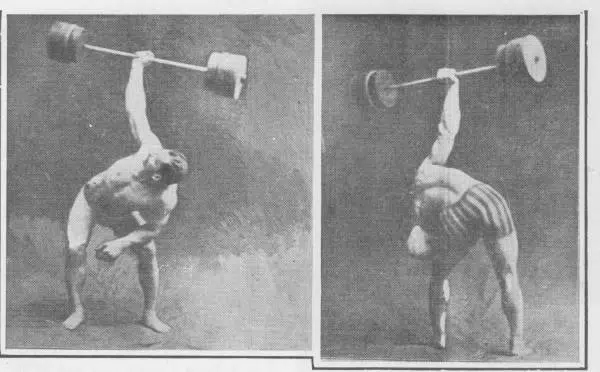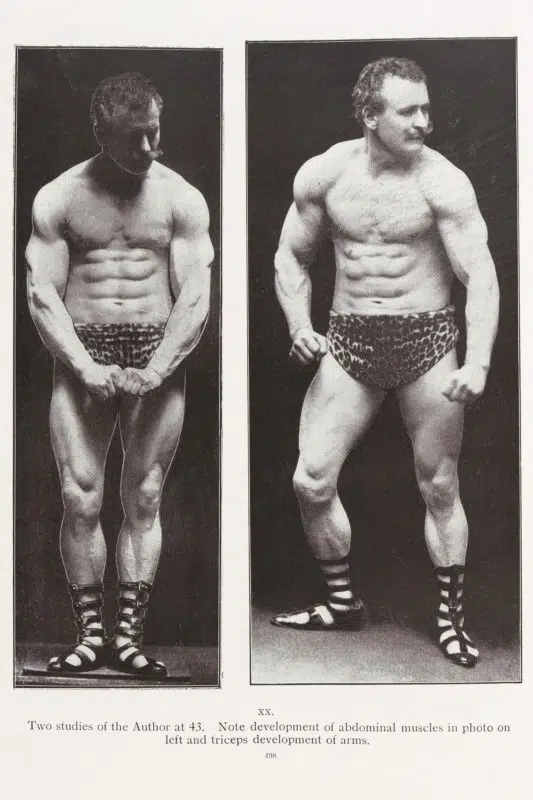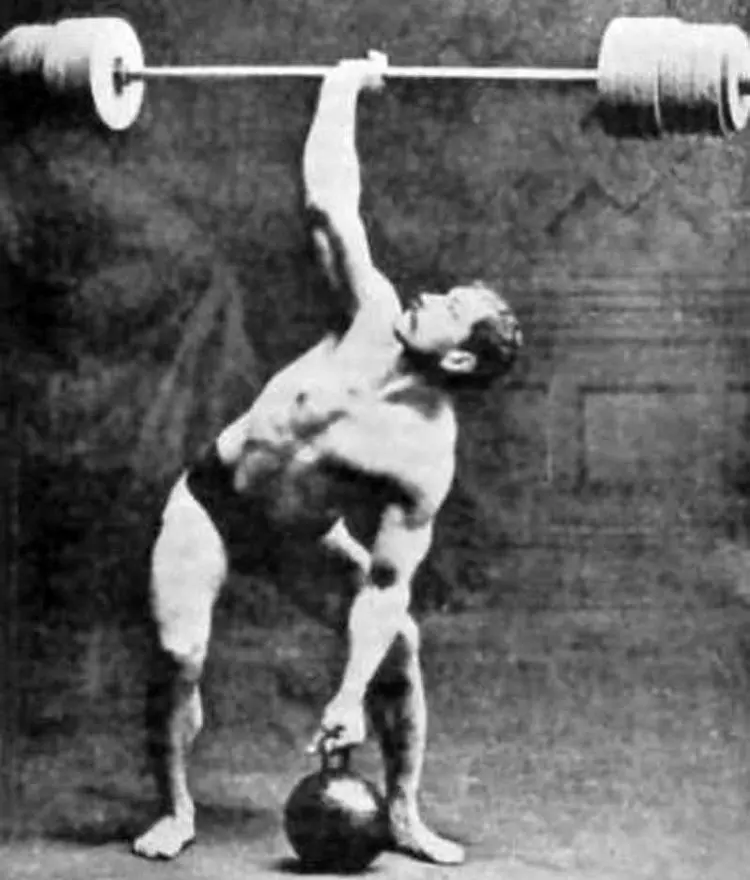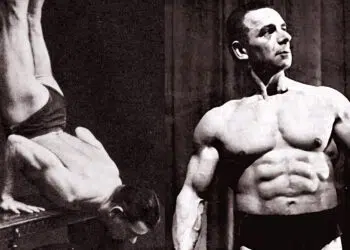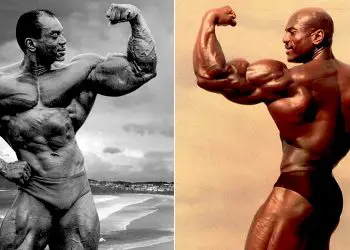Many old-school exercises look pretty odd by today’s standards. Before the leg press, bench press, pec deck, and lat pulldown became workout staples, bronze and silver-era bodybuilders performed things that often looked more like circus tricks than gym exercises.
Exercises that were popular in the past but are seldom performed today include:
Many of these forgotten exercises involved awkward body positions, uneven loads, and extreme ranges of motion. Some, like Steinborn squats, were potentially dangerous!
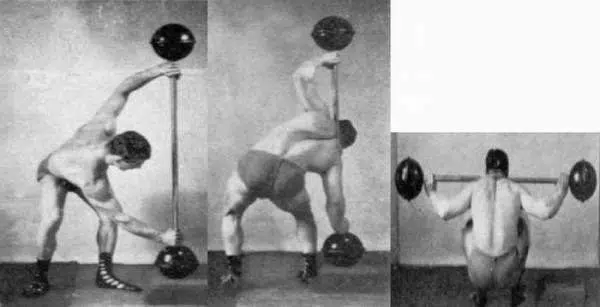
However, that didn’t stop the lifters of the day from hoisting huge weights and building massive muscles with these unique movements.
Another popular but largely forgotten exercise is the bent press. Performed with a dumbbell, kettlebell, or even a barbell, this classic exercise was a favorite of old-time professional strongman Arthur Saxon (April 28, 1878 – August 6, 1921).
Level Up Your Fitness: Join our 💪 strong community in Fitness Volt Newsletter. Get daily inspiration, expert-backed workouts, nutrition tips, the latest in strength sports, and the support you need to reach your goals. Subscribe for free!
Saxon, nicknamed the Iron Master, was one of the strongest lifters of the time, and held many world records, not least in the bent press. In fact, his record of 386 lb. (175.1 kg) still stands today, and it’s rumored he successfully lifted 400 lb. in training.
In this article, I explain why and how to do the bent press, and how to incorporate it into a modern workout.
Bent Press Basics
The bent press is a unilateral or single-armed upper-body exercise. Unlike conventional overhead presses, you do the bent press while leaning over to the side, so your upper body is all-put parallel to the floor. Once your arm is extended, you then stand up straight to complete the lift.
This unique movement means that the bent press not only works your arms and shoulders but your core, too.
The main muscles developed by bent presses are:
- Deltoids – all three heads
- Rotator cuff
- Pectoralis major – especially the clavicular or upper head
- Triceps
- Obliques
Here’s a video of legendary old-time strongman W.A. Pullman performing the bent press circa 1922 with a heavy barbell. Note that he’s lifting in his regular street clothes, including a tie!
How to Do the Bent Press
While old-time strongmen often did the bent press with a heavy barbell, anyone learning this exercise should start with a light dumbbell/kettlebell. This will be easier to balance and control, leaving you free to focus on perfecting your lifting technique.
Follow these step-by-step instructions and then watch the accompanying video to learn how to do the bent press.
- Stand with your feet roughly shoulder-width apart, toes turned slightly outward.
- Lift and hold your weight at shoulder height. Tuck your elbow into your side so it’s resting on your hip. Your forearm should be vertical. Brace your core.
- Lean away from the weight while keeping your forearm vertical. Rest your other forearm on your thigh and use it for support.
- Shift your hips to the side to ensure your body is under the weight. Look at the weight and keep your eyes fixed on it for the entire lift.
- Press the weight straight up so your arm is now vertical and perpendicular to your body.
- Keeping your arm extended and vertical, push on your thigh and use your opposite arm to help you stand up. Bend your legs slightly if necessary, but do not drop into a full squat, as that’s a different exercise.
- The lift is complete when you are standing upright, weight held overhead.
Advantages and Benefits of the Bent Press
There are plenty of easier ways to develop your shoulders, triceps, and core which begs the question, do bent presses deserve a place in your training program? Consider these advantages and benefits and then decide!
A Functional Exercise
Functional exercises develop strength that transfers to activities performed outside the gym. The bent press puts you in an awkward position, requires mobility and stability, and uses one arm at a time in a standing position. As such, it will make many out-of-the-gym and athletic activities feel much easier.
Identify and Fix Left-to-Right Strength Imbalances
While it’s normal to have one arm or leg slightly stronger than the other, big strength imbalances can cause postural issues, injuries, and pain. You’ll soon discover if you have one arm stronger than the other with bent presses, and you can use this classic old-school exercise to fix your imbalances.
Increased Upper Body Strength
The bent press targets all your upper body pushing muscles, namely the deltoids, upper pecs, and triceps. As such, working on your bent press will likely improve your overhead and bench press performance.
Better Shoulder Stability
The bent press is an inherently unstable exercise, and you’ll have to work hard to control the weight in such an awkward position. This demand increases significantly if you use a barbell. All this need for control means your rotator cuff works overtime during bent presses.
The rotator cuff is a group of four small muscles – supraspinatus, infraspinatus, teres minor, and subscapularis. These muscles work together to control your shoulder joint and prevent unwanted movement. A stronger rotator cuff may help to prevent future shoulder injuries.
Increased Core Strength
Core is the collective name for the muscles of your midsection, including the rectus abdominis, obliques, transverse abdominis, and erector spinae. These muscles encircle, support, and control your spine.
Bent presses involve a lot of core engagement and, as such, work your midsection as much as your shoulders and triceps. It’s no coincidence that old-school strongmen had powerful, defined abs despite doing very little direct midsection training.
Better Shoulder and Spine Mobility
While the bent press is undeniably a strength exercise, performing it involves a large range of motion at both the shoulder joint and the spine. As such, adding bent presses to your workouts will improve shoulders and spine mobility and flexibility. That said, you need good mobility and flexibility to perform this exercise in the first place.
Level Up Your Fitness: Join our 💪 strong community in Fitness Volt Newsletter. Get daily inspiration, expert-backed workouts, nutrition tips, the latest in strength sports, and the support you need to reach your goals. Subscribe for free!
Related: Loosen Up! Five-Minute Mobility Workout for Lifters
Bent Press Drawbacks and Disadvantages
While there are advantages and benefits to doing bent presses, there are several drawbacks and disadvantages, too. Consider the following before you add this exercise to your workouts.
Injury Risk
The bent press is a potentially risky exercise. Firstly, you need a high degree of mobility and stability to perform it correctly, even with light loads. Secondly, losing control of the weight, e.g., if it falls behind you, could cause severe injury.
That’s not to say that you shouldn’t do the bent press. However, exercisers should weigh up the risks vs. the benefits to determine if it’s worth performing. In some instances, the juice will not be worth the squeeze.
Technically Demanding
Conventional shoulder presses and most modern strength training exercises are relatively straightforward, making them safe and easy to learn. In contrast, the bent press is an extremely complex exercise and much harder to master.
Some lifters may struggle to get to grips with this movement, especially if they have no one to teach them how to do it correctly. It goes without saying that the bent press is best left to intermediate and advanced lifters, and beginners should avoid it.
Not So Effective for Hypertrophy
Bent presses are usually performed for very low reps, often singles. While such low-rep training is perfect for building brute strength, it’s less effective for hypertrophy or building muscle. So, if you want massive deltoids and triceps, regular overhead presses done for 6-30 reps to failure are a much more effective, research-backed option (1).
Programming the Bent Press
The bent press is best done for low reps – often singles. As such, it’s a good exercise for building strength. However, start light and master the movement before attempting to lift heavy loads. Losing control of a heavy kettlebell, dumbbell, or barbell could result in serious injury, especially to your shoulders or back.
My favorite way to program bent presses is as an EMOM exercise. Short for every minute on the minute, EMOM works brilliantly for low-rep, single-limbed training.
To do EMOM bent presses, start a timer and do one rep with your right arm. Rest until the top of the next minute and then do a rep with your left arm. Continue alternating sides minute-by-minute for 8, 10, or 12 minutes to rack up 4, 5, or 6 reps per side. You could even extend your EMOM workout to 20 minutes, accumulating an impressive ten reps per arm.
Alternatively, light, slow bent presses are an excellent mobility exercise that works well as part of a lifting-specific warm-up. Put it near the end of your warm-up routine to mobilize your shoulders, hips, and lower back.
Bent Press Alternatives and Variations
The bent press is a great old-school exercise for building pressing strength, shoulder stability, and upper body mobility, one arm at a time. However, it’s not the only exercise that offers these benefits. Here are some bent press alternatives and variations to try.
1. Kettlebell Windmill
The kettlebell windmill is a great way to prepare for the bent press and an excellent exercise in its own right. With this movement, you keep your arm extended overhead as you bend sideways into that familiar bent press position. Use this exercise to get used to flexing your spine laterally while holding a weight overhead.
2. Turkish Get-Up
The Turkish get-up, also known as the TGU, or just the get-up, is another old-school exercise that requires and develops mobility, stability, and strength all at the same time. This movement has experienced a resurgence in popularity over the last two decades as it’s now a staple of kettlebell and CrossFit training.
3. Two-Hands Anyhow Lift
If you thought the bent press was crazy, the two-hands anyhow lift will blow your mind! With this exercise, you do a bent press but then pick up another weight as you stand upright. Old-school strongmen made this exercise as hard as possible by holding a different size/weight implement in each hand.
4. Barbell Sots Press
The barbell Sots press is named after Viktor Sots, a Soviet weightlifter from the 1970s and 1980s. Famed for his incredible strength and technique in the Olympic clean and jerk, Sots credited much of his success to the exercise that bore his name. Like the bent press, this unique movement develops strength, mobility, and stability simultaneously.
5. Single-Arm Dumbbell Overhead Squat
The last part of the bent press somewhat resembles an overhead squat. So, if you find finishing your bent press difficult, it makes sense to isolate this movement and focus on it. The single-arm overhead squat is a great way to work on mobility, stability, and strength but is easier to learn and master than full bent presses.
Conclusion
You won’t see many people training like Arthur Saxon and doing bent presses. That’s because such technically demanding exercises have fallen out of favor and have been replaced by much simpler movements, many of which are machine-based.
This is something of a shame because while machine and conventional freeweight exercises build muscle and strength, they aren’t as functional as those old-school staples.
While I’m not suggesting you quit leg presses, bench presses, and pulldowns in favor of Steinborn squats and Jefferson deadlifts, I do think there is a place in modern training for a few well-chosen old-school lifts.
So, develop your mobility, stability, and strength with the bent press. If nothing else, it’ll make you appreciate just how straightforward things like bench presses and push-ups really are!
References:
- Lasevicius T, Ugrinowitsch C, Schoenfeld BJ, Roschel H, Tavares LD, De Souza EO, Laurentino G, Tricoli V. Effects of different intensities of resistance training with equated volume load on muscle strength and hypertrophy. Eur J Sport Sci. 2018 Jul;18(6):772-780. doi: 10.1080/17461391.2018.1450898. Epub 2018 Mar 22. PMID: 29564973.

